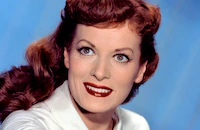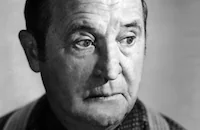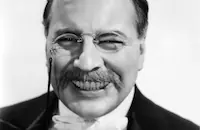Buffalo Bill

Brief Synopsis
Cast & Crew
William A. Wellman
Joel Mccrea
Maureen O'hara
Linda Darnell
Thomas Mitchell
Edgar Buchanan
Film Details
Technical Specs

Synopsis
In 1877, William Frederick Cody, an army scout at a remote frontier post, and a longtime friend of the Cheyenne Indians, is riding one day when he sees a wagon being attacked by a group of Indians. After rescuing the endangered party, which consists of cavalry sergeant Chips McGraw, Senator Frederici and his daughter Louisa and businessman Murdo Carvell, Bill explains to the senator that the drunken Indians meant no real harm. Later, Louisa invites Bill to a dinner party at her home near the fort, much to the despair of Dawn Starlight, a Cheyenne schoolteacher who is in love with Bill. The dinner is interrupted by Chips, who has brought Yellow Hand, the son of Cheyenne chief Tall Bull, to discuss industrialist Schyler Vandevere's plan to build a railroad line through Cheyenne land. Despite Yellow Hand's warning that it will cause war, Vandevere insists he is going through with his project. Journalist Ned Buntline, another guest, is enthusiastic about covering an Indian war, but Bill fears a tragic result. Vandevere begins his construction, and the Cheyenne, led by Yellow Hand, the war chief, begin a campaign of destruction. Dawn Starlight, who is Yellow Hand's sister, sends him word that if he takes Frederici hostage, he can obtain greater peace terms. Frederici is captured, but Bill negotiates for his release, and soon after, a peace treaty is signed. Ned then returns to the East after telling Bill of his intentions to write about him. Louisa, who has fallen in love with Bill, coaxes the shy scout to propose to her, and they are married. Two years pass as Bill and Louisa enjoy a quiet life. One day, the senator brings news that he and Vandevere have started a company dealing in buffalo robes. Bill agrees to direct the operation but is sickened by the slaughter of the buffalo. Bill's anxiety is temporarily forgotten, however, when Louisa announces that she is pregnant. Meanwhile, Yellow Hand meets with Sioux war chief Crazy Horse, and they declare war on the white man for destroying the buffalo, which are their main food source. While the Indians attack in the North, where there are fewer soldiers, Louisa goes into labor as she and Bill are returning to the fort. Soon Bill is presented with a son, whom he names Kit Carson Cody. Upon their arrival at the fort, Bill and Louisa learn that the Sioux have beaten General George Custer's forces, and General Blazier urges Bill to join the Army. Louisa warns Bill that she will take Kit East if he leaves, but Bill feels compelled to accompany the Army. Bill subverts the general's orders, however, so that the leading group of cavalry meets Yellow Hand's forces at War Bonnet Gorge. There, Bill kills Yellow Hand in hand-to-hand combat, and when the Army reinforcements arrive, the Indians are beaten in a bloody battle, during which Dawn Starlight is killed. Despite his despair over the battle, Bill agrees to go to Washington, D.C., where he is to receive the Congressional Medal of Honor for his heroic actions. During the journey, Bill is surprised to learn that Ned's publications about the exploits of "Buffalo Bill" have made him a celebrity. Once in Washington, however, Bill learns that Kit is seriously ill. Bill rushes to Louisa's house, but the child has already died from diphtheria. Grief-stricken, Bill lashes out at Vandevere and other industrialists, accusing them of persecuting the Indians for their own gain. Powerful political forces then align against Bill and ruin his reputation through slander. Penniless, Bill wanders the streets until his sharpshooting at an arcade catches the eye of Sherman, a sideshow owner. Sherman hires Bill as part of his show, and when Louisa finally decides to locate her husband, she finds Bill in the humiliating job. The couple reconcile, but Bill decides that he cannot go home because of the way he has treated the Indians. One afternoon, Ned overhears Bill telling some children that Indian children are just like them, and he convinces Bill to start a rodeo show during which he and his Indian friends can demonstrate their skills. Soon Buffalo Bill's Wild West Show has become a success, and as the years pass, Bill travels throughout the world, performing for royalty, heads of state and adoring youngsters. Years later, after his final performance, Bill thanks his fans and announces that he is retiring so that he and Louisa can return to the West.

Director

William A. Wellman
Cast

Joel Mccrea

Maureen O'hara

Linda Darnell

Thomas Mitchell

Edgar Buchanan

Anthony Quinn

Moroni Olsen
Frank Fenton
Matt Briggs
George Lessey

Frank Orth
George Chandler
Chief Many Treaties
Nick Thompson
Chief Thundercloud

Sidney Blackmer
Edwin Stanley
John Dilson
Evelyn Beresford
Merrill Rodin
Talzumbie Dupea
Larry Lawson
Margaret Martin
George Sherwood
George Bronson
Harry Tyler
Arthur Loft
Syd Saylor
Robert Homans
Billy Bletcher
Cordell Hickman
Gerald Mackey
Eddie Nichols
Fred Chapman
George Nokes
Cecil Weston
John Reese
Vincent Graeff
Fred Graham
Thomas Alan Yazloff
Clint Sharp
Cliff Parkinson
Ben Corbett
Frank Mccarroll
Frank Cordell
Phil Schumacher
John Epper
George Fiske
Joe P. Smith
Jack Carry
Fred Kennedy
Henry Wills
Elmer Ellingwood
Buster Wiles
Lyle Brown
Jack House
Larry Dodds
Don House
Edward Jauregui
Jack Shannon
James Magill
Kermit Maynard
Bob Perry
John Konorez
Carl Andre
Merlyn Nelson
Audrey Scott

Gordon Jones
Walter Robbins
Crew
James Basevi
Joseph Behm
Sidney Bowen
Otto Brower
Alfred Bruzlin
David Buttolph
James B. Clark
Lewis Creber
Joe De Yong
Dick Dickson
William Eckhardt
Roger Heman
Howard Hill
R. L. Hough
Renè Hubert
Natalie Kalmus
Cecile Kramer
John Larkin
Thomas Little
Aeneas Mackenzie
Ray C. Moore
Richard Mueller
Emil Newman
Guy Pearce
Clements Ripley
Fred J. Rode
Fred Sersen
Leon Shamroy
Harry A. Sherman
Charles Stallings
Col. J. G. Taylor
Chief Thundercloud
Frank Winch
Ben Wurtzel
Darryl F. Zanuck

Film Details
Technical Specs

Articles
Buffalo Bill (1944) -
That dynamic was not lost upon director William Wellman or writer Gene Fowler, and it's the reason they were less than enamored with the final picture. Fowler thought Cody "the fakiest guy who ever lived," and wanted to make a movie that would speak to the less-glamorous truth of the man's life. Wellman liked this approach, and the two men spent months researching the real Buffalo Bill. Wellman later said that he and Fowler worked on a screenplay for three months, after which time they had "half a script that was absolutely beautiful."
Then one evening, as Wellman recalled, Fowler phoned him to say he'd decided their approach was all wrong. "You can't kill any of these wonderful heroes that our kids...and everyone else, worship and like," Fowler said. "And that's what we're doing. Buffalo Bill is a great figure, and we cannot do it." In other words, to destroy the legend of Buffalo Bill might have been interesting and truthful, but the moviegoing public would likely have none of it. (It's a theme later explored in The Man Who Shot Liberty Valance [1962] with its famous "print the legend" refrain.) So the two men spent a drunken night tossing their script into a fireplace, one page at a time. "[We] burned up three months of the most wonderful work I've ever done with a writer in my whole life," said Wellman. "[But] he was right."
Eventually, the completed screenplay did indeed perpetuate the heroic, romantic, and probably untrue legend of Buffalo Bill Cody, and Wellman was indeed disgusted by it. But he had no choice but to make the movie because he owed Fox a film for having been permitted to make The Ox-Bow Incident (1943), a film that studio chief Darryl Zanuck disliked as much as Wellman disliked Buffalo Bill.
Wellman said of the finished product, "Having been through this thing with Fowler, it was fakey. I loved Tommy Mitchell in it. And I loved the two girls. I tried to do the best I could." But he despised a scene at the end "when a little crippled boy stands up and says 'God bless you, Buffalo Bill.'" Wellman did not want to shoot that scene, "and when I did, honestly and truly, I turned around and damn near vomited because I think that's the fakiest thing I ever heard. And then Zanuck told me later on [Buffalo Bill] was the second-biggest moneymaker we've ever made."
Audiences seemed not to care about the on-screen fiction of Buffalo Bill's life -- they just responded to a good cast (Joel McCrea, Maureen O'Hara, Linda Darnell, Thomas Mitchell), gorgeous Technicolor cinematography (by Leon Shamroy), and some spectacular action scenes. O'Hara, in fact, later wrote that she believed it was the Technicolor photography that made the film such a substantial box-office success. (She otherwise never thought much of the film and still doesn't.)
Buffalo Bill contains an iconic cavalry vs. Indians battle scene that is one of the most exciting such scenes of the era: the battle of War Bonnet Gorge. To shoot the massive sequence, which was based on a true-life skirmish, Wellman had a river dammed up so that it would leave just a little water over the entire valley floor where the battle takes place. But flash floods washed out the dam three times, costing the studio a lot of money. Zanuck gave Wellman one more chance, and finally he got it. Just in time, too -- the next day another flash flood washed it out again.
The battle footage was so thrilling that Fox re-used it in several other westerns, including the opening of Pony Soldier (1952) and the ending of The Siege at Red River (1954). Film historian William K. Everson later wrote, "Critics with short memories were easily fooled. To a man they praised the battle scene that was over a decade old, and pointed out how much better wide-screen films could present this sort of mass action than the 'old-fashioned' small screens!"
Critics did not receive Buffalo Bill too well, though they all praised the battle scene. The New York Times seemed resigned to the myth-perpetuating attitude of the film, stating: "As a purely romantic fiction about the great man who had the Wild West show -- the man who was bathed in clouds of glory by millions of American boys -- this film is as credible as many of the stories which Cody told about himself... Buffalo Bill's was a fantastic legend, and Twentieth Century-Fox has done nothing to tear it down."
Trade paper Variety, on the other hand, gave a very strong review and called it "a magnificent production" with "topflight" photography and "outstanding" sound recording.
Fox released Buffalo Bill before The Ox-Bow Incident, and while the former scored box-office gold, the latter made no dent with moviegoers, though critics loved it. In truth, Zanuck hated Ox-Bow so much that he barely released it, so it never had a real chance. But The Ox-Bow Incident has since become regarded as one of the great classics of the era, while Buffalo Bill is remembered mainly for its rousing battle scene and technical merits.
A final cast note: Linda Darnell plays a young Indian woman who teaches in a frontier school, and the studio publicity department announced that she was perfect for the part because she had "a few drops" of Cherokee blood in her. That being said, Darnell's character does deliver some lines about racism that are quite progressive for 1944.
By Jeremy Arnold
SOURCES:
Ronald L. David, Hollywood Beauty: Linda Darnell and the American Dream
Aubrey Malone, Maureen O'Hara: The Biography
Maureen O'Hara with John Nicoletti, 'Tis Herself
Richard Schickel, The Men Who Made the Movies
Tony Thomas, Joel McCrea: Riding the High Country
Frank T. Thompson, William A. Wellman

Buffalo Bill (1944) -
Quotes
Trivia
When Sgt. Chips is delivering mail at the beginning of the film, one of the mailboxes he delivers to is labeled "2nd Lt. A. MacKenzie". 'Aeneas MacKenzie' was one of the film's writers.
Notes
This film is based on the life of William Frederick "Buffalo Bill" Cody (1846-1917). Cody's legendary exploits as a Pony Express rider, Army scout, Indian fighter, buffalo hunter and showman were popularized in the dime novels of writer Ned Buntline. Although some of the incidents in the film, such as Cody's fight with Cheyenne leader Yellow Hand and his being awarded the Medal of Honor are true, others were not. His wife Louisa, for example, was not the daughter of a senator, and the couple had three other children besides Kit Carson Cody, who actually died of scarlet fever. Numerous films have been made featuring Cody as a character, including the 1926 Sunset Productions film Buffalo Bill on the U.P. Trail, starring Roy Stewart (see AFI Catalog of Feature Films, 1921-30; F2.0675); the 1936 Paramount film The Plainsman, featuring James Ellison as Cody (see AFI Catalog of Feature Films, 1931-40; F3.3472); and the 1976 picture Buffalo Bill and the Indians or Sitting Bull's History Lesson, starring Paul Newman. Cody himself appeared in a number of films, including the 1901 Biograph release Buffalo Bill's Wild West Parade (see AFI Catalog of Feature Films, 1893-1910; A.01833) and the 1917 Essanay release The Adventures of Buffalo Bill (see AFI Catalog of Feature Films, 1911-20; F1.0024). The Twentieth Century-Fox Records of the Legal Department, located at the UCLA Arts-Special Collections Library, contains several letters from Cody's relatives, some of which protested that the picture was being made without their permission. Others complained after the film was released that the depiction of Cody was grossly inaccurate. No claims were filed, however, and the studio maintained that because Cody was dead, they did not have to obtain the rights to his life story from any of his surviving relatives.
According to information in the legal records and the Twentieth Century-Fox Produced Scripts Collection, also located at UCLA, the studio purchased the rights to Frank Winch's unpublished story, entitled "Pahaska," from producer Harry Sherman, who had originally intended to make the film at Paramount. Sherman assigned Harrison Jacobs to write the screenplay, and planned to shoot it in Wyoming, according to a February 1939 Los Angeles Times news item. Fox's purchase of Sherman's rights to "Pahaska" included the rights to other works by Winch, upon some of which the screenplay May have been based. They include: The Thrilling Lives of Buffalo Bill, Col. William F. Cody, Last of the Great Scouts and Pawnee Bill, Major Gordon W. Lillie, White Chief of the Pawnees (1911); Buffalo Bill as I Knew Him (1928); and "Buffalo Bill-Frontiersman" (Ace High Magazine, January 3, 1929 -18 September 1929). According to a studio press release, "Americana expert" George Milburn was to collaborate with credited writer Aeneas McKenzie on the screenplay, but the extent of his contribution to the completed picture has not been confirmed. A June 14, 1943 Hollywood Reporter news item noted that Sherman originally intended for Lesley Selander to act as the second unit director.
A June 1943 version of the screenplay, contained in the scripts collection, includes the following foreword: "In recognition of the valor and devotion of those Indian warriors who are now in the armed forces of our nation, Twentieth Century-Fox Studios dedicates to a race that ever fought for freedom, this story of its greatest friend and foeman." In a July 14, 1943 story conference, however, studio production chief Darryl F. Zanuck objected to the dedication, saying "in this we are reminded of a situation which we would rather not have brought up: our ignoble treatment of the American Indian." The story conference also reveals that Vincent Price was originally scheduled to play "Murdo Carvell," but was replaced when the part was cut. Hollywood Reporter production charts list Price in the cast, however, along with E. J. Ballantine, whose participation in the completed film has not been confirmed. According to several contemporary sources, the buffalo hunting sequence was filmed on the Crow Indian Reservation in Montana, and many sequences were shot on location in Zion National Park and Kanab, Utah. The majority of the Indians in the film were played by Navajo Indians from Arizona.

Miscellaneous Notes
Released in United States 1944
Released in United States on Video November 22, 1989
Released in United States 1944
Released in United States on Video November 22, 1989













